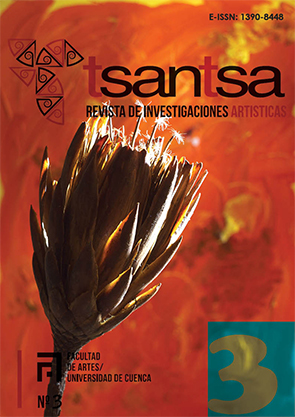CUERPOS VIVOS SENTIENTES: NUEVAS MIRADAS SOBRE LA RELACIÓN EJECUTANTE - EXPECTANTE EN EL ARTE ESCÉNICO
Resumen
SENTIENT LIVING BODIES: NEW PERSPECTIVES ON THE RELATIONSHIP OF PERFORMER - EXPECTANT IN THE PERFORMING ARTS
Resumen:
Analizamos el acto empático a partir de los estudios de la filósofo Edtih Stein y lo ampliamos hacia las reflexiones contemporáneas de Peter Pál Pelbart sobre las nociones espinosistas del individuo definido desde su grado de potencia para comprender la relación ejecutante y expectante en el arte escénico. Partimos de la concepción de que la empatía es la base del arte escénico ya que al tratarse de un arte vivo y presencial, la relación entre intérprete y espectador se torna vital. Nos sumergimos en el universo de las relaciones intersubjetivas donde encontramos que estos vínculos son significativos tanto para el arte como para el entendimiento del mundo y la realidad de cualquier ser humano, así como la comprensión del sí (mismo). La empatía se presenta, entonces como un acto vivencial que busca evidenciar el estar en el mundo, como la experiencia de un ser en construcción cognoscente en el tiempo y en el espacio. Es así que encontramos en el fenómeno experiencial de la empatía una herramienta para ampliar el entendimiento sobre el fenómeno escénico y la técnica del ejecutante.
Palabras clave: Empatía, intersubjetividad, fenomenología, arte escénico.
Abstract:
We analyze the empathetic act from of the studies of the philosopher Edtih Stein and we extend it towards the contemporary reflections of Peter Pál Pelbart on espinosistas notions of the individual defined from his degree of power to understand the performer and expectant relationship in the performing arts. We start from the idea that empathy is the base of the scenic art since it is a live and personally art, the relationship between performer and spectator becomes vital. We immerse ourselves in the universe of intersubjective relations where we find that these links are significant both for art and for the understanding of the world and the reality of any human being, as well as the understanding of his (self). Empathy is presented, then as an existential act that seeks evidence of being in the world, as the experience of a Knower under construction in time and space. It is thus that we find in the experiential phenomenon of empathy a tool to broaden understanding about the scenic phenomenon and the technique of performer.
Keywords: Phenomenology, empathy, intersubjectivity, performing arts.
Descargas
Citas
Andrade, Javier. (2015) Primer Informe del proyecto de investigación: La sonoesfera performática como espacio para la experiencia rizomática. Cuenca: Facultad de Artes, Universidad de Cuenca.
Bardet, Marie. (2015) - A Atenção através do Movimento: o método Feldenkrais como disparador de um pensamento sobre a atenção. En Revista Brasileira de Estudos da Presença, Porto Alegre, v. 5, n. 1, p. 191-205, jan./abr. 2015. Disponible en: <http://www.seer.ufrgs.br/presenca>.
Bianchi, Paloma y Nunes, Sandra Meyer Nunes. (2015). A Coordenação Motora como Dispositivo para a Criação: uma abordagem somática na dança contemporânea. En Revista Brasileira de Estudos da Presença, Porto Alegre, v. 5, n. 1, p. 148-168, jan./abr. Disponible en: <http://www.seer.ufrgs.br/presenca>.
Calvino, Ítalo. (1990). Seis propostas para o próximo milênio. São Paulo, Brasil: Companhia das Letras.
Hanna, Thomas. (1976). The Field of Somatics. En: Somatics – Magazine Journal, Vol.1-1, California.
Hanna, Thomas. (1994). Somática: recuperar el control de la mente sobre el movimiento, la flexibilidad y la salud. México D.F.: Ed. Yug.
Haya, Fernando S. (2008). Sobre el problema de la empatía. En Urbano Ferrer (Ed.), Para comprender a Edith Stein (pp.185-214). Madrid: Ed. Palabra.
McDaniel, Kris. (forthcoming) Edith Stein: on the problem of empathy. En Schliesse, Eric (Ed.)Ten Neglected Philosophical Classics, Oxford University Press. Recuperado de http://krmcdani.mysite.syr.edu/ESPOE.pdf3
Pár Pelbart, Peter. (2008). Podríamos partir de Espinosa. En Saadi, F. y García, S. (Cord.) Revista Questões da Teatralidade Contemporânea. São Paulo: Itaú Cultural, p.32-37.
Reason, Mathew. (2010). Asking the Audience: Audience research and the experience of theatre, En: Revista About Performance, No 10, (pp 15-34).
Stein, Edith. (2004). Sobre el problema de la empatía. Traducción José Luis Caballero Bono. Madrid: Ed. Trotta.



